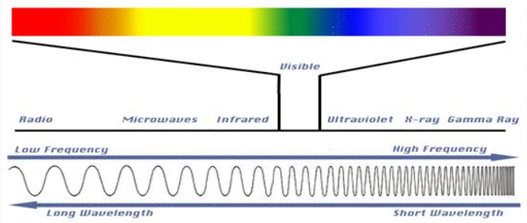Welcome to the Physics of Stopping Light! This website is designed to provide a basic explanation the conditions required to stop light. Start by reading about what properties define light. Next, visit the Bose-Einstein Condensate tab to learn about what conditions must be present when stopping light. Finally, read about the experiment itself and future applications of bringing light to a stand still.
Note: You may notice that some words are highlighted orange which indicates that the word is linked to the definition page or another website.
Note: You may notice that some words are highlighted orange which indicates that the word is linked to the definition page or another website.
The photo above illustrates The Electromagnetic Spectrum.
What is light?
The fundamental concept of light is that it is energy. This energy is composed of photons which travel through space at different wavelengths and frequencies.
Light goes beyond “optical light,” which is what you see, Light is energy. It can also be understood as electromagnetic radiation that exists in a variety of different sizes of wavelengths. Wavelength measures the distance from one peak of a wave to the peak of the next wave. The theory of electromagnetism suggests that light as electric and magnetic fields traveling through the universe as a wave. The electromagnetic spectrum distinguishes the wavelengths of into different frequencies, or how many waves per second (Radio waves, Microwaves, Infra-red, Visible Light, Ultra-violet, X-rays and Gamma rays).
Light is made up of an incredible amount of photons, which are tiny particles composed of electromagnetic energy. The photons mass is determined by the amount of energy each photon holds. The size of the proton determines what wavelength the light will be.
As for the physical properties of light, it has a finite velocity. In a vacuum light travels at a speed of 186,282.4 miles/second (299,792,458 meters/second). In these conditions of scientist deem the speed of light a universal physical constant. When scientist discusses objects in deep space they use the fastest speed that they know, light. A light year travels about 5.88 trillion miles/year or about 9.46 quadrillion meters /second. To put this into perspective, it would take light 0.018 seconds to travel from Fairbanks, Alaska to New York City!
The relationship between the energy of a photon and the wavelength of a photo can be defined by Einstein’s mass-energy equivalence, E = M * (C*C). The equivalence of energy is E is measured in joules, where m is the mass(kilograms) and c is the speed of light constant.
Energy(photon) = M(mass) * C(speed of light squared)
Watch the YouTube link below sponsored by Ted-Ed to gain a better understanding on the behavior of light.
Light is made up of an incredible amount of photons, which are tiny particles composed of electromagnetic energy. The photons mass is determined by the amount of energy each photon holds. The size of the proton determines what wavelength the light will be.
As for the physical properties of light, it has a finite velocity. In a vacuum light travels at a speed of 186,282.4 miles/second (299,792,458 meters/second). In these conditions of scientist deem the speed of light a universal physical constant. When scientist discusses objects in deep space they use the fastest speed that they know, light. A light year travels about 5.88 trillion miles/year or about 9.46 quadrillion meters /second. To put this into perspective, it would take light 0.018 seconds to travel from Fairbanks, Alaska to New York City!
The relationship between the energy of a photon and the wavelength of a photo can be defined by Einstein’s mass-energy equivalence, E = M * (C*C). The equivalence of energy is E is measured in joules, where m is the mass(kilograms) and c is the speed of light constant.
Energy(photon) = M(mass) * C(speed of light squared)
Watch the YouTube link below sponsored by Ted-Ed to gain a better understanding on the behavior of light.
